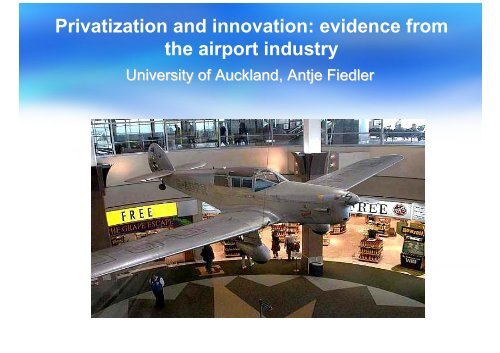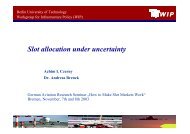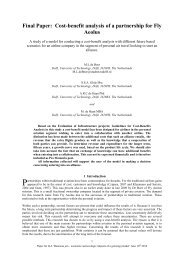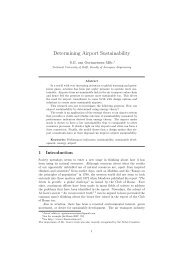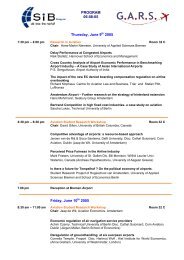Antje Fiedler - GARS - German Aviation Research Society
Antje Fiedler - GARS - German Aviation Research Society
Antje Fiedler - GARS - German Aviation Research Society
Create successful ePaper yourself
Turn your PDF publications into a flip-book with our unique Google optimized e-Paper software.
Privatization and innovation: evidence from<br />
the airport industry<br />
University of Auckland, <strong>Antje</strong> <strong>Fiedler</strong>
Overview<br />
• Introduction<br />
• Clarification of key terms<br />
• Theoretical framework<br />
• Selected cases<br />
• Q & A
Why do governments privatize?<br />
Privatization includes:<br />
Enhance allocative & productive efficiency<br />
Incentives for cost & quality innovation<br />
• Deregulation (opening markets to competition)<br />
market & institutional environment<br />
• Transfer of state-owned assets to the private sector<br />
property-rights
Institutional and market environment<br />
Institutions<br />
• Institutions are formal and informal rules that influence, enable<br />
or constrain human behaviour (North, 2005)<br />
• Created by human agency<br />
• Incentive structure of society incentives for innovation<br />
Market environment<br />
• According to Baumol (2002): market mechanism is the key to<br />
economic welfare<br />
• Institutions foster free-market pressure (competition)<br />
force firms to innovate
Institutional actors<br />
Organizational level:<br />
• Organizations are understood as institutions<br />
• Different stakeholders’ exercise strategic choice<br />
Level of society:<br />
• Organizations respond to the market & institutional<br />
environments<br />
• Organizations can exercise strategic choice
Organizational change & innovation<br />
Individual level<br />
Organizational level<br />
Industry level<br />
Societal level<br />
Employee Managers Owners<br />
Institutional<br />
Actor<br />
Competition<br />
&<br />
Regulation<br />
Corporate<br />
Governance<br />
system<br />
Organizational<br />
change & innovative<br />
behaviour<br />
Innovativeness<br />
of<br />
industry<br />
Innovative<br />
Capacity<br />
Micro<br />
Macro<br />
Ramamurti (2000) also developed “A multi-level model of privatization”
The organizational level: organizational<br />
change<br />
• When institutional change is introduced (privatization), it is<br />
likely that the affected companies have to adapt to the new<br />
environment (Johnson, Smith & Codling, 2000; Greenwood<br />
and Hinings, 1993).<br />
• Companies have individual freedom to choose between actions<br />
in relation to their institutional environment (Child, 1972).<br />
• Decisions about organizational change depend on the<br />
perception as to which choice benefits in the future. This<br />
perception is influenced by the incentives that the institutional<br />
framework provides (North, 2005).<br />
• The strategic choice of organizations may, in turn, impact on<br />
the institutional environment (Aldrich & Ruef, 2006).
The industry level: competition & regulation<br />
• A competitive environment is very important in promoting the<br />
creation of innovation (Baumol, 2005). Van Slyke (2003)<br />
argues that improved efficiency in the context of privatization<br />
will only occur when competition has been introduced<br />
successfully.<br />
• There is consensus that competition at the industry level<br />
benefits the outcome of privatization (Kay & Thompson, 1986;<br />
Dunsire et al. 1991; Vickers & Yarrow, 1991; Bishop &<br />
Thompson, 1992).<br />
• In monopolistic industries, competition may be impractical and<br />
a form of regulation is required (Kay, Mayer & Thompson,<br />
1986). In this case, the performance is largely determined by<br />
the degree of monopoly power and the form of regulation<br />
(Forsyth, 1984).
The society-level: corporate governance<br />
systems (CGS)<br />
• “The governance of the corporation is now as important in the<br />
world economy as the governance of countries” (Wolfensohn<br />
1998, p. 38).<br />
• The CGS determines the nature of competition at the input<br />
markets (labour, manager, capital).<br />
• <strong>Research</strong>ers have explored how the CGS of a country affects<br />
the types of innovations created by organizations (Hall &<br />
Soskice, 2003).<br />
• Some authors have stressed that the CGS plays a crucial role<br />
in the success of privatization (Dyck, 2001; Shleifer & Vishny,<br />
1997).<br />
• Both the level of competition and the CGS significantly affect<br />
companies innovative activities (Pavitt & Patel, 1999).
Aim of this study:<br />
• There is little knowledge as to how different corporate<br />
governance systems and competition have affected<br />
innovation after privatization.<br />
• Privatization provides fertile ground for researching<br />
how different corporate governance systems influence<br />
on organizational change and innovativeness.<br />
<strong>Research</strong> question:<br />
• How do national systems of corporate governance<br />
and different competitive environments influence<br />
innovation in the context of privatization?
Industry of interest:<br />
• The Airport industry<br />
• During the last decade airports have developed from<br />
government-owned entities to sophisticated<br />
commercially-oriented enterprise (“airport cities”)<br />
Case Study- approach: Where?<br />
• New Zealand, UK (LME’s: corporate governance)<br />
• <strong>German</strong>y (CME’s: corporate governance)
Employment<br />
relations & Human<br />
capital (HC)<br />
LME (NZ, UK) CME (<strong>German</strong>y)<br />
Voluntary basis<br />
HC general, (exit)<br />
Financial system Market-based (exit)<br />
Market for corporate<br />
control (high disclosure)<br />
Dispersed shareholdings<br />
by portfolio investors<br />
Top management Single board dominated<br />
by CEO<br />
Corporate goal Shareholder value &<br />
short term<br />
Corporate strategy<br />
from a deterministic<br />
perspective<br />
“big leaps” & radical<br />
innovation<br />
Co-determination by law<br />
HC firm-specific,<br />
(voice)<br />
Bank-based (voice) by<br />
large shareholders<br />
(insider information)<br />
Concentrated ownership<br />
by strategic investors<br />
Dual board<br />
Multiple power<br />
Multiple & long term<br />
“small steps” &<br />
incremental innovation
Airport Competition in New Zealand<br />
By Car: Auckland to<br />
• Wellington: 9hrs 20mins<br />
• Christchurch:14hrs 20mins<br />
(plus ferry crossing* from<br />
Wellington to Picton)<br />
By Train: Auckland to<br />
• Wellington: 12hrs (Overlander)
Airport Competition in <strong>German</strong>y<br />
• Competition between Hubs (transit)<br />
• Frankfurt ca. 53% (2006)<br />
• London Heathrow ca. 35 % (2004)<br />
Competition between airports & other<br />
modes of transport<br />
• By train (speed ca. 300km/h)<br />
• Frankfurt-Cologne Frankfurt Cologne ca. 1h16min.<br />
• Frankfurt-Paris Frankfurt Paris (1h20min flight;<br />
4h03 Min train)
CME<br />
LME<br />
Selected cases<br />
Hamburg airport?<br />
Wellington International<br />
Auckland International<br />
Industry<br />
Monopolistic Competitive<br />
Fraport AG<br />
London Heathrow
Thank you.<br />
Thank you.
Multiple Case study-approach<br />
study approach<br />
Why qualitative research methods?<br />
• “an empirical inquiry that investigates a contemporary phenomenon<br />
within its real-life context” (Yin, 2003, p. 13)<br />
• Allows to choose deliberately cases which have certain<br />
characteristics in order to understand a phenomenon better, and<br />
perhaps to build theory from it (Stake, 2000)<br />
Why not deductive?<br />
Börsch (2004 p. 609) claimed that institutional analysis should be<br />
complemented by firm-level analyses because:<br />
“A stronger actor-centred approach focusing on firms as actors in<br />
their own right may be able to capture better the dynamics of<br />
corporate governance, and analyse how institutions and firm<br />
strategies interact…”
Methods and data analysis<br />
Documents<br />
• archival data (internal and external documents)<br />
• (NVivo7)<br />
Interviews<br />
• semi-structured interviews, open-ended questions<br />
• interview covers areas such as:<br />
- the company’s strategic reorientation<br />
- organizational change<br />
- the company’s learning experience<br />
- key stakeholders
Timeline of the <strong>Research</strong><br />
In the second year Milestones<br />
- Write Chapter 3 - Presentation of first results<br />
- Data collection - Submit Chapter 3<br />
- Data analysis<br />
- Write Case study 1<br />
- Submit Case Study 1<br />
In the third year<br />
- Write Case study 3, 4, 5 - Submit Case Study 2-5<br />
- Write chapter 6 - Submit Thesis<br />
- Finalize PhD


